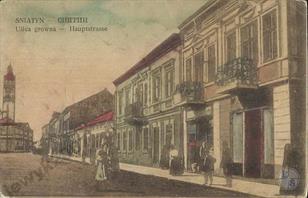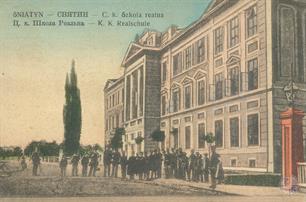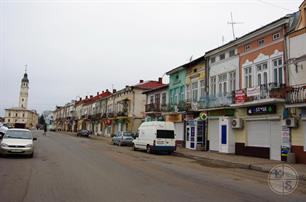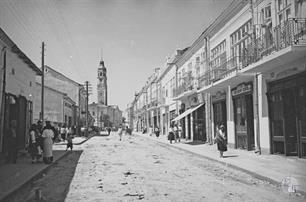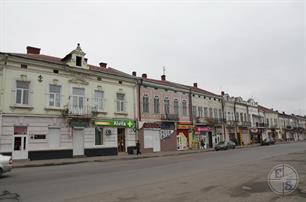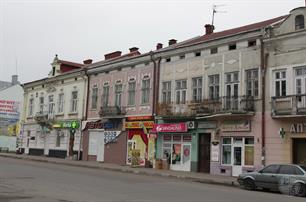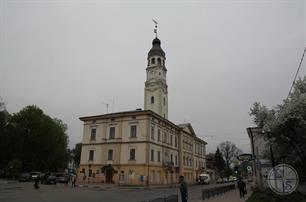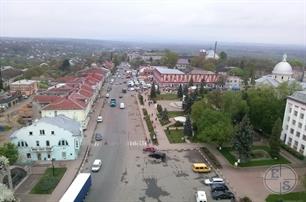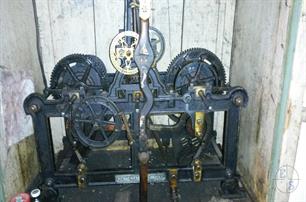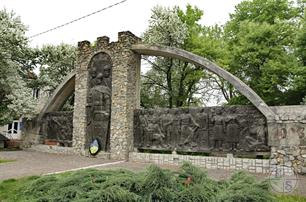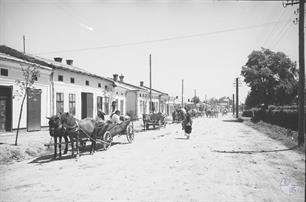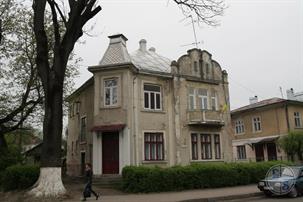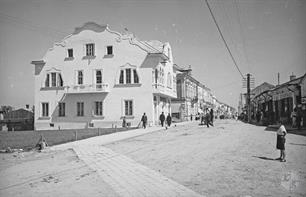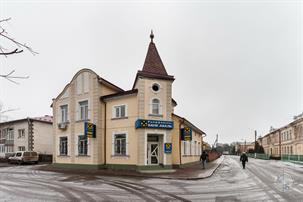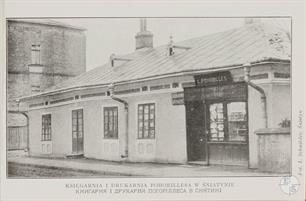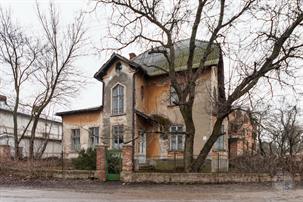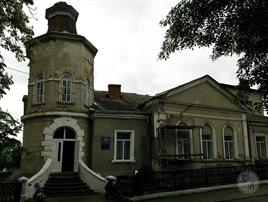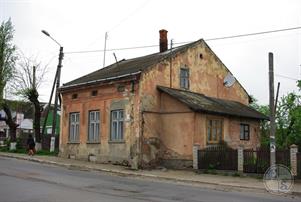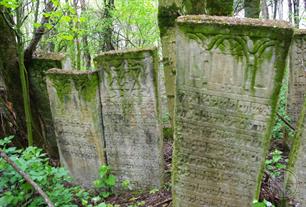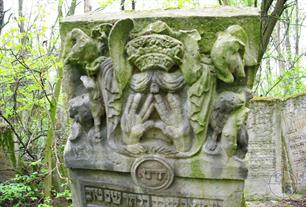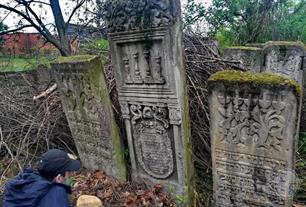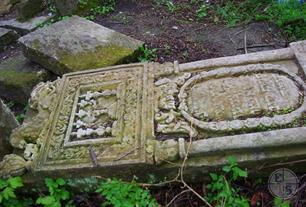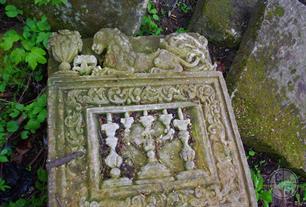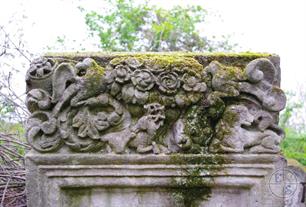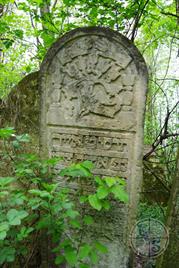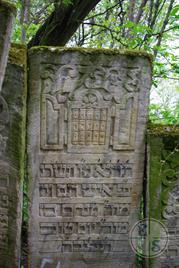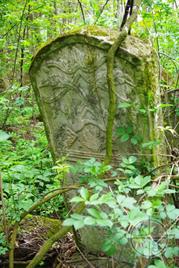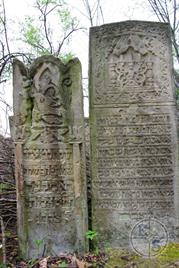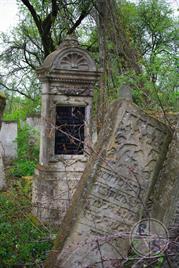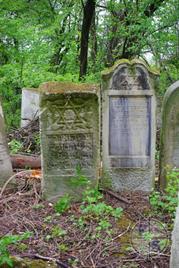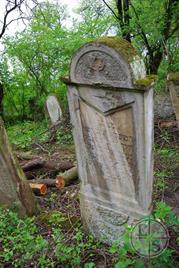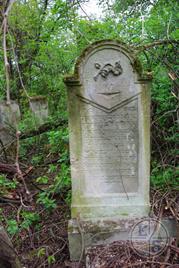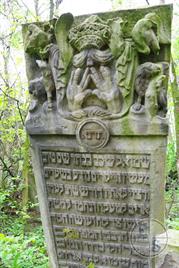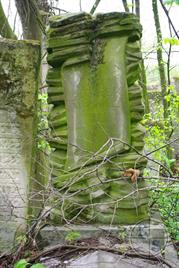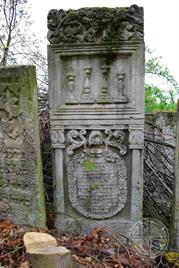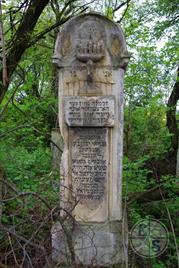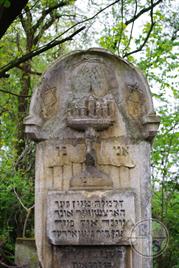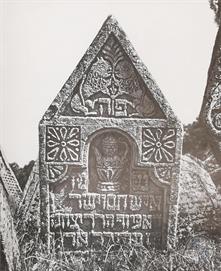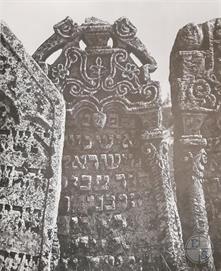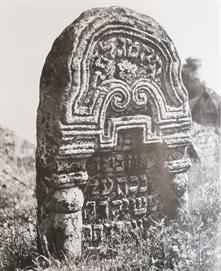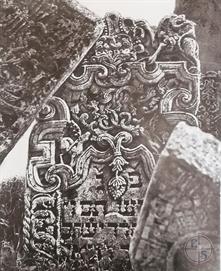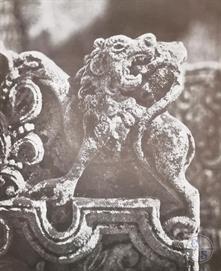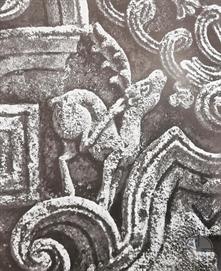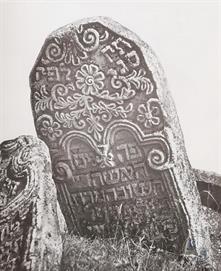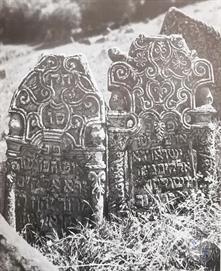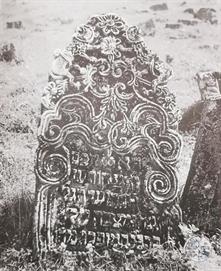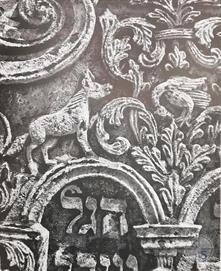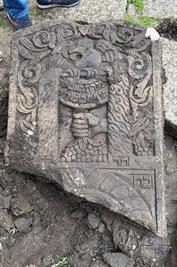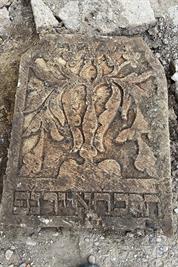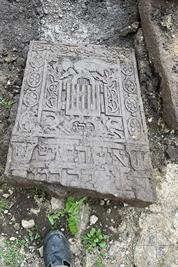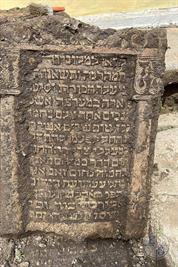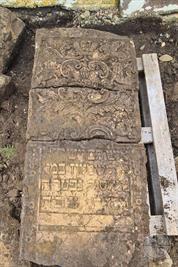Sniatyn
Kolomyia district, Ivano-Frankivsk region
Year - Total Population - Jews
1765 - (?) - 1,111
1880 - 10,832 - 2,333
1890 - 10,939 - 3,916
1900 - 11,500 - 4,206
1910 - 12,242 - 4,386
1921 - 10,597 - 3,248
1765 - (?) - 1,111
1880 - 10,832 - 2,333
1890 - 10,939 - 3,916
1900 - 11,500 - 4,206
1910 - 12,242 - 4,386
1921 - 10,597 - 3,248
Sources:
- Pinkas Hakehillot Polin: Encyclopedia of Jewish Communities, Poland, Volume II, page 516-519, published by Yad Vashem, Jerusalem. Translated by Dr. Steven Maron, JewishGen, Inc.
- Goberman D. Jewish tombstones in Ukraine and Moldova. St. Petersburg, 2001
Photo:
- Eugene Shnaider (2016)
- Vitaliy Kamozin (2023)
- David Goberman (1950s)
- Мандрівка Старим Кордоном. Снятин
- Pinkas Hakehillot Polin: Encyclopedia of Jewish Communities, Poland, Volume II, page 516-519, published by Yad Vashem, Jerusalem. Translated by Dr. Steven Maron, JewishGen, Inc.
- Goberman D. Jewish tombstones in Ukraine and Moldova. St. Petersburg, 2001
Photo:
- Eugene Shnaider (2016)
- Vitaliy Kamozin (2023)
- David Goberman (1950s)
- Мандрівка Старим Кордоном. Снятин
Snyatyn (ukr. Sniatyn, Снятин) functioned as a border city even back in the times of the Reissen Principality. In 1340, it was annexed to Poland and since that time became an important commercial center, especially with the fairs that took place there. The first mention of Snyatyn as a city was in 1411. In 1531, most of the city was burned, and in 1570 it was hit by a plague.
Traces of these disasters were still detectable in the year 1571, at a time when there were only 46 houses in the city. In order to help rehabilitate the city, the king of Poland undertook measures such as referring merchants to the city and releasing them from taxes. In the beginning of the second half of the 16th century, Snyatyn was already famous for its commerce, which was very developed, and for its very big fairs that took place there and attracted merchants from as far away as Hungary, Greece, and Walachia.
This prosperity continued but stopped during the Turkish invasion of 1589. The Turks burned most of the city and took many of the inhabitants prisoner.
In the year 1620, the Polish Parliament decided to arm Snyatyn with weapons and ammunition so that it would be able to withstand the siege. In 1628, Armenians and people of others “faiths,” in addition to being released from taxes, were given many new privileges.
Among the most important of these were the right to settle in new Snyatyn, to engage without limitation in commerce and in crafts, and to enjoy the right of self-jurisdiction. Other important privileges were the possibility of acquiring land and the ability to use the land for farms and honey refineries.
Traces of these disasters were still detectable in the year 1571, at a time when there were only 46 houses in the city. In order to help rehabilitate the city, the king of Poland undertook measures such as referring merchants to the city and releasing them from taxes. In the beginning of the second half of the 16th century, Snyatyn was already famous for its commerce, which was very developed, and for its very big fairs that took place there and attracted merchants from as far away as Hungary, Greece, and Walachia.
This prosperity continued but stopped during the Turkish invasion of 1589. The Turks burned most of the city and took many of the inhabitants prisoner.
In the year 1620, the Polish Parliament decided to arm Snyatyn with weapons and ammunition so that it would be able to withstand the siege. In 1628, Armenians and people of others “faiths,” in addition to being released from taxes, were given many new privileges.
Among the most important of these were the right to settle in new Snyatyn, to engage without limitation in commerce and in crafts, and to enjoy the right of self-jurisdiction. Other important privileges were the possibility of acquiring land and the ability to use the land for farms and honey refineries.
Jews as Snyatyn inhabitants are mentioned for the first time in 1563, but even before that time they came to Snyatyn from Poland and the East as merchants to the fairs. We only know of an organized community in Snyatyn from the middle of the 16th century, and according to the 1564-65 census, there were then 10 Jewish families of 60 souls.
In the years 1564-70, Jews leased three flour mills near the city, as well as groats mills and wax factories. In 1578, the Jews of Snyatyn had bestowed upon them a very broad bill of rights which equalized their status with that of other city inhabitants.
They were allowed to settle without limitation in all parts of the city, to acquire houses, and to engage in commerce without interference.
In 1628, the new Snyatyn was founded next to the old city, and the Jews of the city, together with the Greeks, were given permission to settle there. Since Snyatyn was a border city, it functioned for the Jewish merchants as a crossing point for the passage of merchandise from Germany to the Ottoman empire. The customs station of Snyatyn was leased to Jews: in the years 1627-34, to a Jew by the name of Markovich; and in 1664 to another Jew, Yitzchak Nachmanovich.
The economic importance of the Jews of Snyatyn was then on the increase. In 1650, several Jewish persons stood before the city rulers and demanded that they be given municipal rights identical to those of the other inhabitants. In exchange for these rights, they were willing to be obliged to pay all customary taxes.
The Christians agreed to the demands of the Jews, and thus the Jews were allowed to engage in commerce, and to live in and own inns as well as shops. These rights were re-authorized and ratified by the king in 1660.
In the same year, the Jews of Snyatyn received the right of leasing for hard liquor.
In 1661, it was again agreed between the Snyatyn municipality and the Jews that there would be equal rights for the Jews in areas of commerce, inn keeping, and manufacture of hard liquor.
In 1717, Israel, the head of the community of the Jews of Snyatyn, paid 137 gold coins as a tax. In 1765, there were 229 houses in the city which were owned by Jews. The Jewish community continued to develop in the 19th century, but a decline began in the beginning of the 20th century. In 1906, a fire broke out which burned down 200 Jewish homes, and as a result hundreds of Jewish families were without shelter.
The economic situation also began to decline, and in 1911 several Ukrainian shops and cooperatives were established which competed with the Jewish shops and hurt their business. There was much suffering caused to the Jewish community during the Russian conquest of 1914-15.
In May, 1915, the Russian authorities exiled all the Jews towards Chortkov, and they were not allowed to take any of their possessions with them.
In the years 1564-70, Jews leased three flour mills near the city, as well as groats mills and wax factories. In 1578, the Jews of Snyatyn had bestowed upon them a very broad bill of rights which equalized their status with that of other city inhabitants.
They were allowed to settle without limitation in all parts of the city, to acquire houses, and to engage in commerce without interference.
In 1628, the new Snyatyn was founded next to the old city, and the Jews of the city, together with the Greeks, were given permission to settle there. Since Snyatyn was a border city, it functioned for the Jewish merchants as a crossing point for the passage of merchandise from Germany to the Ottoman empire. The customs station of Snyatyn was leased to Jews: in the years 1627-34, to a Jew by the name of Markovich; and in 1664 to another Jew, Yitzchak Nachmanovich.
The economic importance of the Jews of Snyatyn was then on the increase. In 1650, several Jewish persons stood before the city rulers and demanded that they be given municipal rights identical to those of the other inhabitants. In exchange for these rights, they were willing to be obliged to pay all customary taxes.
The Christians agreed to the demands of the Jews, and thus the Jews were allowed to engage in commerce, and to live in and own inns as well as shops. These rights were re-authorized and ratified by the king in 1660.
In the same year, the Jews of Snyatyn received the right of leasing for hard liquor.
In 1661, it was again agreed between the Snyatyn municipality and the Jews that there would be equal rights for the Jews in areas of commerce, inn keeping, and manufacture of hard liquor.
In 1717, Israel, the head of the community of the Jews of Snyatyn, paid 137 gold coins as a tax. In 1765, there were 229 houses in the city which were owned by Jews. The Jewish community continued to develop in the 19th century, but a decline began in the beginning of the 20th century. In 1906, a fire broke out which burned down 200 Jewish homes, and as a result hundreds of Jewish families were without shelter.
The economic situation also began to decline, and in 1911 several Ukrainian shops and cooperatives were established which competed with the Jewish shops and hurt their business. There was much suffering caused to the Jewish community during the Russian conquest of 1914-15.
In May, 1915, the Russian authorities exiled all the Jews towards Chortkov, and they were not allowed to take any of their possessions with them.
In the community of Snyatyn, there were several well-known rabbis. One of the first of these was Reb Moshe haLevi, son of Meir Heller. It is known that he was in Snyatyn in 1780. After him came Reb Yosef Ginsberg in about 1792.
In 1820, Reb Aaron Moshe Toybish served as head of the beth din. He died in 1852. Among his works are The Horns of the Ram and The Thousand Fold of the Ram. His successor came in 1842, and that was Reb Moshe, son of Reb Yosef, who served as head of the beth din (he died in 1868 or, according to another version, in 1870). At another time, Reb David Meir, son of Yosef, functioned as head of the beth din (before that, he was the rabbi of Provozhna). He founded a society for visitation of the sick and from its income assisted the local chevra kadisha.
Reb David Meir emmigrated to Safed before 1888 and functioned as a rabbi there until his death in 1894.
Reb Avraham Menachem Mendel haLevi Steinberg also functioned as a rabbi. He went to Brody in 1907 and died there in 1928. Between the years 1869 and 1875, Reb Yona, son of Reb Shlomo Ashkenazi from Pashborzk, functioned as Synatyn's rabbi, and he was the author of The Breastplate (he died in 1885).
In 1905, Reb Naftali Meshulam Feivish haLevi Gottesman settled in Snyatyn – the admor from Lashkovich [our father, our teacher, our rabbi] – and he held court there until his death in 1913. The place of Reb Naftali Meshulam was taken by his son, Rev Shimshon Efraim, who died in the Holocaust with his entire family.
During the first decade of the 20th century, the rabbi of Snyatyn was Reb Menachem Mendel Brenner, and beside him, also serving as rabbi, was Reb Avraham Menachem haLevi Steinberg.
In 1820, Reb Aaron Moshe Toybish served as head of the beth din. He died in 1852. Among his works are The Horns of the Ram and The Thousand Fold of the Ram. His successor came in 1842, and that was Reb Moshe, son of Reb Yosef, who served as head of the beth din (he died in 1868 or, according to another version, in 1870). At another time, Reb David Meir, son of Yosef, functioned as head of the beth din (before that, he was the rabbi of Provozhna). He founded a society for visitation of the sick and from its income assisted the local chevra kadisha.
Reb David Meir emmigrated to Safed before 1888 and functioned as a rabbi there until his death in 1894.
Reb Avraham Menachem Mendel haLevi Steinberg also functioned as a rabbi. He went to Brody in 1907 and died there in 1928. Between the years 1869 and 1875, Reb Yona, son of Reb Shlomo Ashkenazi from Pashborzk, functioned as Synatyn's rabbi, and he was the author of The Breastplate (he died in 1885).
In 1905, Reb Naftali Meshulam Feivish haLevi Gottesman settled in Snyatyn – the admor from Lashkovich [our father, our teacher, our rabbi] – and he held court there until his death in 1913. The place of Reb Naftali Meshulam was taken by his son, Rev Shimshon Efraim, who died in the Holocaust with his entire family.
During the first decade of the 20th century, the rabbi of Snyatyn was Reb Menachem Mendel Brenner, and beside him, also serving as rabbi, was Reb Avraham Menachem haLevi Steinberg.
We find the beginning of Zionist activity in Snyatyn in 1894, when a group of 80 members was founded calling itself Bnei Zion [Sons of Zion].
In 1897, a chapter of Ahavat Zion [Love of Zion] was founded, and in 1906 a benevolent society was founded whose main aim was encouragement of the Hebrew language and its literature.
In 1908, a chapter of the Mizrachi was founded, and in 1909, a socialist Jewish union.
In 1912, a nationalist women's club named Ruchel was founded and functioned mainly in the cultural arena. In 1913, a club was founded called Degel Yehuda [Flag of Judah], which included many academic Zionists (students and graduates of high school).
A Hebrew school founded by the Baron Hirsch [Fund] was opened in 1900, at which time it had only one grade, but in 1910 the number of pupils rose to 186.
In 1904, a chapter of Jeshurun was founded in which gemara was taught as well as Jewish history and Hebrew.
In 1912, there was a Hebrew school in Snyatyn that served 225 pupils.
In 1897, a chapter of Ahavat Zion [Love of Zion] was founded, and in 1906 a benevolent society was founded whose main aim was encouragement of the Hebrew language and its literature.
In 1908, a chapter of the Mizrachi was founded, and in 1909, a socialist Jewish union.
In 1912, a nationalist women's club named Ruchel was founded and functioned mainly in the cultural arena. In 1913, a club was founded called Degel Yehuda [Flag of Judah], which included many academic Zionists (students and graduates of high school).
A Hebrew school founded by the Baron Hirsch [Fund] was opened in 1900, at which time it had only one grade, but in 1910 the number of pupils rose to 186.
In 1904, a chapter of Jeshurun was founded in which gemara was taught as well as Jewish history and Hebrew.
In 1912, there was a Hebrew school in Snyatyn that served 225 pupils.
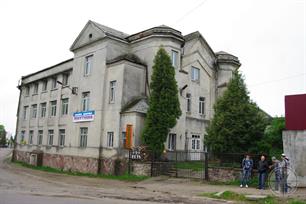 |
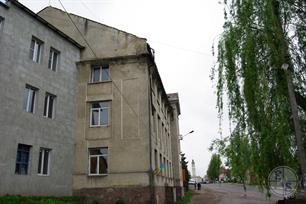 |
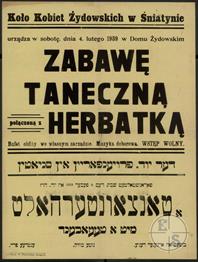 |
| The building of the former synagogue in Sniatyn, 2016 | 1939 announcement. The Circle of Jewish Women organizes a dance evening |
Between World Wars
During the period of the Western Ukraine Republic between 1918-19, the Jews suffered, especially the merchants among them. Even with the renewal of Polish rule, their situation did not improve. Jewish commerce was hurt by an economic boycott, which was accompanied by antisemitic propaganda which increased especially during the 1930's.
In 1923, the local military commander ordered local Jews to house soldiers in their homes. The soldiers mistreated their Jewish hosts, the same way they mistreated the general Jewish population. This difficult situation forced the local Jews to turn to benevolent organizations of Jews in Poland and outside of it.
In 1923 in Snyatyn, a charitable fund was founded, and in 1929 this fund gave 21 loans to needy Jews in the amount of 2,100 zlotys.
In 1935-36, the number of loans went up to 153 for a total of 13,290 zlotys.
In 1928, a credit cooperative was functioning in Snyatyn. It received grants from the Joint [American Jewish Joint Distribution Committee].
In 1926, there were several orphanages operational in Snyatyn. They took care of 30 orphans who also learned crafts in these institutions.
In later years, the institution was in dire straits because of lack of funds. During the same years, several relief organizations were founded, among which was the Jewish women's club called Lev Tov [Good Heart] which took care of needy children. This organization received help from the organization of Jewish women of Snyatyn in the United States. Every day it gave lunch to 120 children and also gave medicine to the needy.
Zionist activity was renewed in Snyatyn at about the time of the end of the First World War. A chapter of the Shomer Hatzair [Young Guard] was already in existence in 1918, and its activities continued until almost the time of the Second World War. Next to the chapter, a library was operating.
In 1924, there were chapters of Ezra, Hechalutz, and Poalei Zion [workers of Zion].
In 1925, a battle raged between the Poalei Zion organization and the Bund for influence over the working class of the Jews. The needleworkers left the labor union of the Bund and went over to the Poalei Zion.
The Poalei Zion organization was operational in 1927.
In the same year, a chapter of Beitar was also founded. It numbered 50 members.
In 1933, a chapter of Achva was founded with 30 members. It organized Hebrew courses.
In the 30's, chapters of Zionist youth, Gordonia and Akiba, were founded.
During the period of the Western Ukraine Republic between 1918-19, the Jews suffered, especially the merchants among them. Even with the renewal of Polish rule, their situation did not improve. Jewish commerce was hurt by an economic boycott, which was accompanied by antisemitic propaganda which increased especially during the 1930's.
In 1923, the local military commander ordered local Jews to house soldiers in their homes. The soldiers mistreated their Jewish hosts, the same way they mistreated the general Jewish population. This difficult situation forced the local Jews to turn to benevolent organizations of Jews in Poland and outside of it.
In 1923 in Snyatyn, a charitable fund was founded, and in 1929 this fund gave 21 loans to needy Jews in the amount of 2,100 zlotys.
In 1935-36, the number of loans went up to 153 for a total of 13,290 zlotys.
In 1928, a credit cooperative was functioning in Snyatyn. It received grants from the Joint [American Jewish Joint Distribution Committee].
In 1926, there were several orphanages operational in Snyatyn. They took care of 30 orphans who also learned crafts in these institutions.
In later years, the institution was in dire straits because of lack of funds. During the same years, several relief organizations were founded, among which was the Jewish women's club called Lev Tov [Good Heart] which took care of needy children. This organization received help from the organization of Jewish women of Snyatyn in the United States. Every day it gave lunch to 120 children and also gave medicine to the needy.
Zionist activity was renewed in Snyatyn at about the time of the end of the First World War. A chapter of the Shomer Hatzair [Young Guard] was already in existence in 1918, and its activities continued until almost the time of the Second World War. Next to the chapter, a library was operating.
In 1924, there were chapters of Ezra, Hechalutz, and Poalei Zion [workers of Zion].
In 1925, a battle raged between the Poalei Zion organization and the Bund for influence over the working class of the Jews. The needleworkers left the labor union of the Bund and went over to the Poalei Zion.
The Poalei Zion organization was operational in 1927.
In the same year, a chapter of Beitar was also founded. It numbered 50 members.
In 1933, a chapter of Achva was founded with 30 members. It organized Hebrew courses.
In the 30's, chapters of Zionist youth, Gordonia and Akiba, were founded.
Jewish cemetery in Sniatyn - one of the most beautiful in Galicia.
During elections for the Zionist Congress of 1931, the general Zionists got 242 votes, the Mizrachi 168, Hitachdut 282, Revisionists 47, and Radicals 1 vote. As said before, the Hebrew school in Snyatyn was already in existence from before the First World War and had two teachers. Its activities were renewed in 1918, at which time there were eight classes, and the number of pupils rose to 195.
In community leadership, the people with the mandate continued to rule and overpowered the Zionists and took away their right to be elected.
In 1931, when five Zionists, out of eight committee members, were elected, the community leadership was scattered by the government and an ad hoc committee was established. In the 30's, Reb Aaron Hofen functioned as the city rabbi.
During the 1933 elections for the municipality, it was agreed among the representatives of the three ethnic groups that each one of them would get eight mandates. From among the Jews, five Zionists, one nationalist, one religious, and one craftsman were elected.
In 1939, there were no elections as a result of a compromise reached beforehand, and eight Poles, eight Ukrainians, and eight Jews were elected. A Jew was chosen as the head of the municipality.
From among the cultural institutions and sport institutions in Snyatyn, we must mention Beth Haam [House of the People] which was dedicated in 1931. In 1934, there was a sport club of the Hapoel.
In community leadership, the people with the mandate continued to rule and overpowered the Zionists and took away their right to be elected.
In 1931, when five Zionists, out of eight committee members, were elected, the community leadership was scattered by the government and an ad hoc committee was established. In the 30's, Reb Aaron Hofen functioned as the city rabbi.
During the 1933 elections for the municipality, it was agreed among the representatives of the three ethnic groups that each one of them would get eight mandates. From among the Jews, five Zionists, one nationalist, one religious, and one craftsman were elected.
In 1939, there were no elections as a result of a compromise reached beforehand, and eight Poles, eight Ukrainians, and eight Jews were elected. A Jew was chosen as the head of the municipality.
From among the cultural institutions and sport institutions in Snyatyn, we must mention Beth Haam [House of the People] which was dedicated in 1931. In 1934, there was a sport club of the Hapoel.
Unfortunately, the most beautiful matzevas from Jevish cemetery have disappeared. According to historians, the Soviet authorities used them to build a fish farm.
The photographs were taken by David Goberman in 1950-60.
The photographs were taken by David Goberman in 1950-60.
In 2023, part of the matzevas was found in the courtyard of one of the houses, where they were used as paving.
Through the efforts of the Jewish community of Ivano-Frankivsk and the United Jewish Community of Ukraine, work was organized to transfer these tombstones to the cemetery.
Through the efforts of the Jewish community of Ivano-Frankivsk and the United Jewish Community of Ukraine, work was organized to transfer these tombstones to the cemetery.
The Second World War
In September of 1939, hundreds of Polish Jewish refugees from western Poland arrived in Snyatyn. They had tried to cross the Romanian border, and many of them were left behind when units of the Soviets came into the city and the Romanian border was closed. Many of them were exiled at the end of June, 1940 to remote areas of the Soviet Union after they refused to accept Soviet citizenship. In Snyatyn, there were arrests on an economic basis, and most of the detainees were accused of speculation. Several Jews with a bourgeois background were forbidden to live in the city because of its proximity to the border. When the war between the Soviet Union and Germany broke out, a small group of Jews succeeded in escaping eastward at the end of June, 1941.
In the beginning of July, 1941, Snyatyn was captured by units of the Romanian army, allies of the Germans. The Romanian soldiers robbed the Jews of their possessions and marked Jewish homes so that the homes would continue to be targeted for looting and forced labor.
About a week after it was conquered by the Romanians, the Romanians rioted in the city with the cooperation of the Ukrainian elements, and more than 20 Jews were murdered.
Romanian soldiers killed Jewish refugees from the Bukowina and Bessarabia who were trying to seek shelter in Snyatyn.
The Romanians ruled the city for about two weeks after which the rule went over to the Hungarians. The Hungarians continued to take Jews for forced labor, but the Hungarian military ruler restrained the Ukrainians to a certain degree, who continued to try and hurt the Jews. Those Jews who were taken for forced labor were occupied in reaping grain and in road and bridge repair.
In September of 1941, rule of the city was transferred to the Germans. Immediately there was a census of the Jews, with an emphasis on the ages of 15-60, those who were required to participate in forced labor. All cows, horses, and wagons belonging to Jews were confiscated.
At the same time, the Judenrat was set up. At its head was the dentist, Cohen. The Judenrat was responsible for supplying people for forced labor, and they were also responsible for the many Jews who came to Snyatyn from surrounding villages during September and October.
In the end of September, 1941, the Germans arrested 30 Jews and demanded a high ransom for their release. Even though the ransom was paid, they were not released but, as soon became known, they were executed in the Potoczek forest near the city. Before their executions, they were forced to dig their own graves.
During the months of October and December, 1941, executions of Jews continued in the Potoczek forest near Snyatyn. There were about 500 victims of this carnage. In the beginning of 1942, the Jews were concentrated in a special quarter of the city. The quarter included eight alleys, and into this quarter were put hundreds of exiled Jews from surrounding communities. There was extreme overcrowding in the quarter. Sanitary conditions were quite difficult, and hunger and disease claimed many victims.
In September of 1939, hundreds of Polish Jewish refugees from western Poland arrived in Snyatyn. They had tried to cross the Romanian border, and many of them were left behind when units of the Soviets came into the city and the Romanian border was closed. Many of them were exiled at the end of June, 1940 to remote areas of the Soviet Union after they refused to accept Soviet citizenship. In Snyatyn, there were arrests on an economic basis, and most of the detainees were accused of speculation. Several Jews with a bourgeois background were forbidden to live in the city because of its proximity to the border. When the war between the Soviet Union and Germany broke out, a small group of Jews succeeded in escaping eastward at the end of June, 1941.
In the beginning of July, 1941, Snyatyn was captured by units of the Romanian army, allies of the Germans. The Romanian soldiers robbed the Jews of their possessions and marked Jewish homes so that the homes would continue to be targeted for looting and forced labor.
About a week after it was conquered by the Romanians, the Romanians rioted in the city with the cooperation of the Ukrainian elements, and more than 20 Jews were murdered.
Romanian soldiers killed Jewish refugees from the Bukowina and Bessarabia who were trying to seek shelter in Snyatyn.
The Romanians ruled the city for about two weeks after which the rule went over to the Hungarians. The Hungarians continued to take Jews for forced labor, but the Hungarian military ruler restrained the Ukrainians to a certain degree, who continued to try and hurt the Jews. Those Jews who were taken for forced labor were occupied in reaping grain and in road and bridge repair.
In September of 1941, rule of the city was transferred to the Germans. Immediately there was a census of the Jews, with an emphasis on the ages of 15-60, those who were required to participate in forced labor. All cows, horses, and wagons belonging to Jews were confiscated.
At the same time, the Judenrat was set up. At its head was the dentist, Cohen. The Judenrat was responsible for supplying people for forced labor, and they were also responsible for the many Jews who came to Snyatyn from surrounding villages during September and October.
In the end of September, 1941, the Germans arrested 30 Jews and demanded a high ransom for their release. Even though the ransom was paid, they were not released but, as soon became known, they were executed in the Potoczek forest near the city. Before their executions, they were forced to dig their own graves.
During the months of October and December, 1941, executions of Jews continued in the Potoczek forest near Snyatyn. There were about 500 victims of this carnage. In the beginning of 1942, the Jews were concentrated in a special quarter of the city. The quarter included eight alleys, and into this quarter were put hundreds of exiled Jews from surrounding communities. There was extreme overcrowding in the quarter. Sanitary conditions were quite difficult, and hunger and disease claimed many victims.
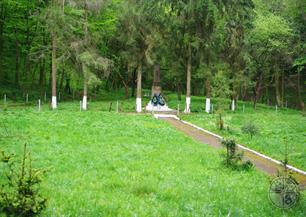 |
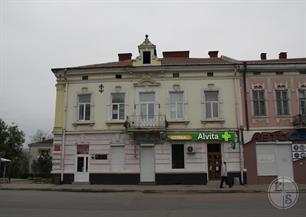 |
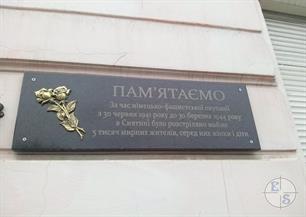 |
| Monument at the mass grave of the murdered Jews of Sniatyn | Former Jewish house on Shevchenko street, 143 | Memorial plaque on the house on Shevchenko street, 143 |
On the first day of Passover in the Jewish year of 5702 [April 2, 1942], all Jews were required to report to a concentration point, but most preferred to hide. Units of the German army, police, and Ukrainian militia concentrated all those who did come in the public gymnasium, and they were held there for a week.
During this action, the Germans and their assistants continued to bring Jews from the surroundings into the gymnasium. Ultimately, there were 5,000 persons concentrated in that area. The conditions were terrible. Many died of thirst. Some were trampled to death, and the Germans and the Ukrainians shot into the crowd and murdered tens of people that way. The only ones released from the area were a group of persons with vital professions, who were given over to the local Wehrmacht commanders. All those remaining were taken to the train station, were put on freight cars, and were taken to their destruction in Belzec camp.
Among the remnants of the community, efforts at salvation increased. Groups of youngsters and even some families tried to escape to Romania, but only a few succeeded. In the summer months of 1942, Romanian border patrols captured many of these refugees and turned them over to the German police. After interrogation and torture, they were executed.
In the ghetto itself, bunkers were dug in order to find shelter during actions. In July of 1942, more exiles from surrounding areas were put into the ghetto, among them Jews from Zablotov.
The liquidation of the ghetto began on September 7, 1942. The Germans and their assistants set fire to part of the ghetto in order to find the hiding places of those that were hiding. Once again Jews were rounded up and placed in the gymnasium.
The hunt continued for four days. Some of the Jews were murdered in the streets of the city or in the gymnasium itself. At the end of the action, the victims were brought in a line to the train station. The distance to the train station was 4 kilometers, and many walked the distance with chained hands. While crossing a bridge, the Germans and Ukrainians shot a number of Jewish women, and their bodies were thrown off the bridge to the river below.
About 1,500 of the remaining Jews of Snyatyn were sent for destruction to Belzec camp. Only a few managed to save themselves by jumping off the train. Many of the jumpers were killed by shots from the German guards, and others were turned in to the police by the local population and immediately murdered. Snyatyn was declared Juden rein [cleansed of Jews]. In the area, there was still a small group of craftsmen who worked at an army camp.
Within a few weeks, however, even these few remaining Jews were destroyed. Only about 15 people succeeded in escaping at the last minute to Czernowitz and from there continued secretly into Romania.
In the end of 1944 and the beginning of 1945, the survivors came to Palestine.
During this action, the Germans and their assistants continued to bring Jews from the surroundings into the gymnasium. Ultimately, there were 5,000 persons concentrated in that area. The conditions were terrible. Many died of thirst. Some were trampled to death, and the Germans and the Ukrainians shot into the crowd and murdered tens of people that way. The only ones released from the area were a group of persons with vital professions, who were given over to the local Wehrmacht commanders. All those remaining were taken to the train station, were put on freight cars, and were taken to their destruction in Belzec camp.
Among the remnants of the community, efforts at salvation increased. Groups of youngsters and even some families tried to escape to Romania, but only a few succeeded. In the summer months of 1942, Romanian border patrols captured many of these refugees and turned them over to the German police. After interrogation and torture, they were executed.
In the ghetto itself, bunkers were dug in order to find shelter during actions. In July of 1942, more exiles from surrounding areas were put into the ghetto, among them Jews from Zablotov.
The liquidation of the ghetto began on September 7, 1942. The Germans and their assistants set fire to part of the ghetto in order to find the hiding places of those that were hiding. Once again Jews were rounded up and placed in the gymnasium.
The hunt continued for four days. Some of the Jews were murdered in the streets of the city or in the gymnasium itself. At the end of the action, the victims were brought in a line to the train station. The distance to the train station was 4 kilometers, and many walked the distance with chained hands. While crossing a bridge, the Germans and Ukrainians shot a number of Jewish women, and their bodies were thrown off the bridge to the river below.
About 1,500 of the remaining Jews of Snyatyn were sent for destruction to Belzec camp. Only a few managed to save themselves by jumping off the train. Many of the jumpers were killed by shots from the German guards, and others were turned in to the police by the local population and immediately murdered. Snyatyn was declared Juden rein [cleansed of Jews]. In the area, there was still a small group of craftsmen who worked at an army camp.
Within a few weeks, however, even these few remaining Jews were destroyed. Only about 15 people succeeded in escaping at the last minute to Czernowitz and from there continued secretly into Romania.
In the end of 1944 and the beginning of 1945, the survivors came to Palestine.

- Home
- Shtetls
- Vinnytsia region
- Volyn region
- Dnipro region
- Donetsk region
- Zhytomyr region
- Zakarpattia region
- Zaporizhzhia region
- Ivano-Frankivsk region
- Kyiv region
- Kropyvnytskyi region
- Luhansk region
- Lviv region
- Mykolayiv region
- Odessa region
- Poltava region
- Rivne region
- Sumy region
- Ternopil region
- Kharkiv region
- Kherson region
- Khmelnytskyi region
- Chernihiv region
- Chernivtsi region
- Cherkasy region
- Crimea
- Synagogues
- Cemeteries
- Objects & guides
- Old photos
- History
- Contact
Jewish towns of Ukraine
Jewish towns of Ukraine
My shtetl
My shtetl
Donate
